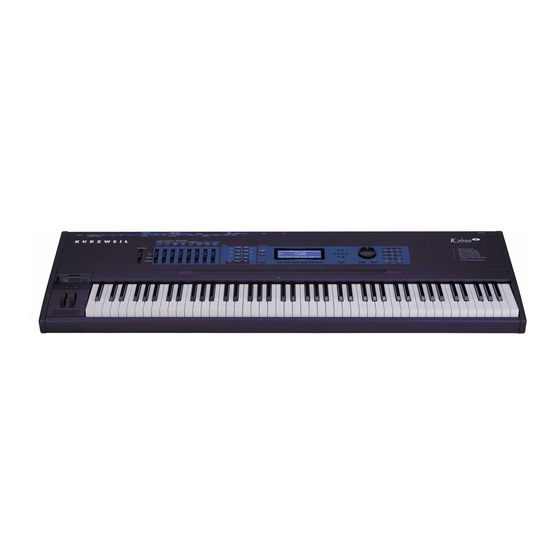
Kurzweil K2600 Interface Manual
User interface basics
Hide thumbs
Also See for K2600:
- Musician's manual (598 pages) ,
- Musician’s reference (347 pages) ,
- Setup manual (49 pages)
Table of Contents
Advertisement
Quick Links
Chapter 3
User Interface Basics
This chapter will show you how to get around the front panel of your K2600. Your interactions
can be divided into three primary operations: mode selection, navigation, and data entry.
Keyboard models also have an assignable control section.
Control
Power switch
LCD contrast
Mode Selection
Navigation
Mode Selection
Navigation
MIDI LED
Disk Drive
User Interface Basics
Data Entry
Data Entry
Audio Inputs
3-1
Advertisement
Table of Contents

Summary of Contents for Kurzweil K2600
-
Page 1: Chapter 3 User Interface Basics
Chapter 3 User Interface Basics This chapter will show you how to get around the front panel of your K2600. Your interactions can be divided into three primary operations: mode selection, navigation, and data entry. Keyboard models also have an assignable control section. -
Page 2: Mode Selection
Mode Selection Mode Selection The K2600 is always in one of eight primary operating modes. Select a mode by pressing one of the mode buttonsÑon keyboard models theyÕre to the left of the display, and on the rack-mount model theyÕre the lower row of buttons under the display. Each mode button has an LED that lights to indicate the current mode. -
Page 3: The Top Line
These navigation buttons will take you to every one of the K2600Õs programming parameters. The Display Your primary interface with the K2600 is its backlit graphic display. As you press various buttons, this ßuorescent display reßects the commands you enter and the editing changes you make. -
Page 4: The Cursor Buttons
WeÕll let you know, when applicable, what the Chan/Bank buttons do. The Edit Button The Edit button activates each of the K2600Õs editors, and acts as a shortcut to many pages within the Program Editor. Pressing the Edit button tells the K2600 that you want to change some aspect of the object marked by the cursor. -
Page 5: Data Entry
Press Exit to leave the current editor. If youÕve changed the value of any parameter while in that editor, the K2600 will ask you whether you want to save your changes before you can leave the editor. See page 5-3 for information on saving and naming. The Exit button also takes you to Program mode if youÕre on the entry level page of one of the other modes. -
Page 6: Double Button Presses
User Interface Basics Data Entry ThereÕs also a convenient feature called keyboard naming, which lets you use the keyboard to enter characters in names. See page 5-5. Double Button Presses Pressing two or more related buttons simultaneously executes a number of special functions depending on the currently selected mode. -
Page 7: Intuitive Data Entry
When editing a multi-layer program (including drum programs), you can quickly switch between layers by holding the Enter button, then striking a key. The K2600 will change the current layer to that keyÕs layer. If the key is part of more than one layer, subsequent key strikes will cycle through each layer that has that key in its range. -
Page 8: Renaming Multiple Objects
This function is not case-sensitive; it will Þnd upper and lower case characters regardless of what you type. When youÕve typed the string of characters you want to Þnd, press Enter. The K2600 searches through the current list of objects or values, Þnds all items that match the string of characters you typed, and displays the Þrst one it Þnds. - Page 9 |||||||||||||||||||||||||||||||||||||||| |||||||||||||||||||||||||||||||||||||||| |||||||||||||||||||||||||||||||||||||||| Delete|Insert||<<<||||>>>||||OK|||Cancel 7. Press OK. The K2600 asks you if youÕre sure (unless you have conÞrmations turned off). Press Yes. The NAME page reappears. Every RAM object whose name contained Bad now contains Good instead. User Interface Basics...
-
Page 10: Panel Play Feature (Rack Models)
1 is C 4, 2 is C which plays C 5. Notes are sent to the K2600Õs sound engine on the current MIDI channel. Pressing the Up or Down cursor buttons while holding Cancel will transpose up or down an octave while using this feature. -
Page 11: Midi Faders Pages
Shows which channels are affected by sliders. On the Mixdown page, pan and volume messages are sent to the internal K2600 sounds, to MIDI Out, or both. All Mixdown-page channels have the same destination (local, MIDI, or both), which is determined by the Control parameter on the MIDI-mode TRANSMIT page. You can assign the sliders to control either volume or pan. -
Page 12: Quick Song Recording And Playback
User Interface Basics Quick Song Recording and Playback The available values for the Channel parameter on this page are 1Ð16 (local and MIDI), 1LÐ16L (local only, no MIDI), and 1MÐ16M (MIDI only, no local). MIDI|Faders:Page1||||||||||||||||||||||| Chan|:|9|||10||11||12||13||14||15||16||| Ctl||:|6|||6|||6|||6|||6|||6|||6|||6|||| Value:|50||0|||50||0|||50||0|||50||0|||| |||||||||||||||||||||||||||||||||||||||| ||||||\]||}~||\]||}~||\]||}~||\]||}~|||| |||||||_|||_|||_|||_|||_|||_|||_|||_|||| Page1||Page2||Page3||Page4|||Send||Done| Quick Song Recording and Playback...








Need help?
Do you have a question about the K2600 and is the answer not in the manual?
Questions and answers